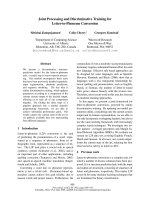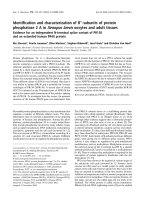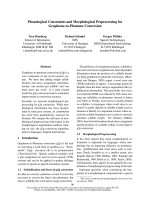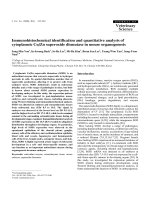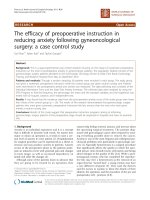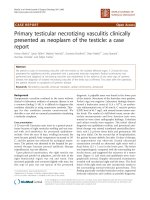báo cáo khoa học: "Ileosigmoid fistula and delayed ileal obstruction secondary to blunt abdominal trauma: a case report" ppsx
Bạn đang xem bản rút gọn của tài liệu. Xem và tải ngay bản đầy đủ của tài liệu tại đây (464.86 KB, 3 trang )
CAS E REP O R T Open Access
Ileosigmoid fistula and delayed ileal obstruction
secondary to blunt abdominal trauma: a case
report
Konstantinos Bouliaris
1
, Dimos Karangelis
2*
, Konstantinos Spanos
1
, Stylianos Germanos
1
, Evangelos Alexiou
3
and
Anargyros Giaglaras
1
Abstract
Introduction: Abdominal trauma is a source of significant mortality and morbidity. Bowel injury as a result of blunt
abdominal trauma is usually evident within hours or days of the accident.
Case presentation: A 38-year-old Caucasian Greek man presented with a subtle and delayed small bowel obstruction
caused by a post-traumatic ileosigmoid fistula and ileal stricture four months after a road traffic accident.
Conclusion: Delayed occurrence of post-traumatic small bowel stricture and ileosigmoid fistula is an uncommon
surgical emergency. General surgeons as well as emergency physicians should bear this manifestation in mind
should a patient return to the hospital several weeks or even years after blunt abdominal trauma with symptoms
or signs of bowel obstruction.
Introduction
The abdomen is the third most commonly injured body
part following trauma [1]. In 85% of cases it is the result of
blunt trauma [2,3]. Solid organs, such as the liver and
spleen, are the most frequently i njured; injuries to the
bowel or mesentery are rare. Although small bowel injury
has been reported to be the third most common injury in
blunt abdominal trauma (BAT), it was diagnosed in only
1.1% of admissions after blunt injury. O nly 0.3% of
patients had a sm all bowel perforation in a multi-institu-
tional study [4]. In the absence of shoc k and peritonitis,
patients with BAT may be treated conservatively and
observed with computerized tomography (CT) [5]. How-
ever, on rare occasions such patients can present later on
with symptoms and signs o f small bowel obstruction or
perforation [6-13]. We present a case of ileal stricture and
an ileosigmoid fistula as a result of BAT.
Case presentation
A 38-year-old Caucasian Greek man presented to our
emergency department complaining of a three-month
history of intermittent abdominal pain and frequent epi-
sodes of diarrhea. He had a history of a previous admis-
sion in another surgical department four months earlier
for BAT after a road traffic accident. At that time he
underwent an abdominal ultrasound, which showed no
intraperitoneal fluid or solid organ injury, and he was
admitted for observation. We al so recovered from his
discharge note that, during the first 48 hours of his hos-
pitalization, a progressive decrease in t he hematocrit
value from 41% to 2 8% was noted. An abdo minal CT
scan at that time showed a small amount of fl uid in the
rectovesical pouch with no solid organ abnormalities
and a large hematoma in the subcutaneous fat tissue on
both lumbar areas. He wa s hemodyna mically stable and
he had a transfusion with one unit of packed red blood
cells and three units of fresh frozen plasma. He
improved rapidly with conservative treatment and was
discharged on the fifth day, asymptomatic. One month
later he started to have episodes of vague abdominal
pains and frequent episodes of diarrhea after meals. Our
patient also mentioned that during that four-month per-
iod he had lost 10 kg in weight. Due to his fear of the
resulting diarrhea, he had cut down on eating.
On our patien t’ s current admission he complained of
a colicky pain at the periumbilical region for the last 24
* Correspondence:
2
Department of General Surgery, 404 Military Hospital Larissa, Greece
Full list of author information is available at the end of the article
Bouliaris et al. Journal of Medical Case Reports 2011, 5:507
/>JOURNAL OF MEDICAL
CASE REPORTS
© 2011 Bouliaris et al; licensee BioMed Central Ltd. This is an Open Access article distributed under the te rm s of the Cr eativ e Commons
Attribu tion License ( which permits unrestricted use, distribution, and reproduction in
any medium, provided the original work is properly cited.
hours and two ep isodes of vomiting. On physical exami-
nat ion his abdomen was mildly distended with a diffuse
tenderness on the hypogastrium. There was no rebound
or guarding and palpation did not reveal any abdominal
masses. His bowel sounds were increased. His blood
tests were unremarkable. Plain abdominal X-rays
revealed a dilated small bowel loop consistent with
intestinal obstruction. He was initially treated with intra-
venous fluid replacement and nasogastric tube but his
symptoms did not resolved. An enhanced-abdominal CT
scan showed a small bowel loop with a thickened wall
and narrow lumen with proximal bowel dilation. There
was also increased density of the adjacent mesenteric fat
(Figure 1). Bearing in mind the episodes of diarrhea as
well as the loss of weight, we included Crohn’s disease
in our differential diagnosis. Further investigation with
colonoscopy and a barium enema did not reveal any
pathology. In view of his continuing symptoms and the
radiological evidence of a small bowel obstruction, a
laparoscopic exploration was carried out. Due to multi-
ple adhesions though, we had to convert our plan to a
laparotomy. During the operatio n we found a thickened
segment of ileum in his pelvis adherent to his bladder
and the apex of the sigmoid loop. There was a stricture
in his ileum at this point, and an ileosigmoid fistula was
present (Figure 2). The abnormal ileal loop was mobi-
lized from his bladder and the sigmoid and resected,
with restoration of intestinal continuity by primary side-
to-side ileoileal anastomosis. The sigmoid fistula point
was closed with seromucosal sutures. Histological exam-
ination of the resected specimen showed a mixed acute
and chronic inflammatory process with hypertrophy of
the muscularis externa. There was no evidence of
Crohn’ s disease or malignancy. Our patient had an
uneventful recovery and was discharged from hospital
nine days later. At follow-up eight months later, he was
symptom free and had regained weight.
Discussion
Traumatic small bowel stricture and delayed small bowel
obstruction secondary to BAT is a rare clinical entity. It is
the result of local ischemia of the bowel wall and its subse-
quent healing with fibrosis and stricture, which causes the
delayed onset of symptoms [12]. This local bowel ischemia
can be caused by an injury to the mesentery, which
impairs the blood supply to the bowel resulting in a steno-
tic segmen t, or a trauma which causes sufficient damage
to the small bowel to result in hemorrhagic mucosal
infarction or subclinical bowel perforation [8,9,12,13].
Patients suffering from post-traumatic small bowel
obstruction usually present with intermittent abdominal
pain and vomiting [9]. The interval between trauma and
theonsetofsymptomsrangesfrom13daysto18years,
although the majority of patients experience symptoms
within four to eight weeks of the initial trauma [9]. When
small bowel obstruction is suspected, the investigation of
choice is a small bowel contrast study or a contrast-
enhanced CT [9,11,14]. Laparot omy and res ection of the
stenosed segment with pri mary anastomosis is the treat-
ment of choice [9].
The presence of free intraperitonea l fluid in the abdo-
men without any evidence of solid organ injury is
indeed an intriguing diagnostic challenge. Concerning
the role of CT, it is unclear if it can provide a solid and
conclusive answer as to whether surgery or close obser-
vation is best. Although CT exhibits very high sensitivity
and specificity in detecting most solid organ injuries, it
can still miss up to 15% of small bowel and mesenteric
injuries [15-17]. We believe that laparotomy is not
Figure 1 Preoperative abdominal CT scan. Shows a small bowel
loop with a thickened wall and narrow lumen with proximal bowel
dilation (black arrow). Increased density of the adjacent mesenteric
fat (white arrow), as well the normal distal ileum (head arrow) can
also be seen.
Figure 2 Intraoperative image. (A) Thickened proximal ileum; (B)
normal distal ileum; (C) fistula point in sigmoid; (D) strictured ileum
segment.
Bouliaris et al. Journal of Medical Case Reports 2011, 5:507
/>Page 2 of 3
warranted in stable patients with free intra-abdominal
fluid as a sole finding, who are otherwise fit and coop-
erative. We suggest close monitoring of these patients,
including continued physical examination along with
further testing if there is any doubt. We would consider
surgical intervention as the last resource in our medi cal
quiver, and only in a deteriorating patient. Many other
authors agree that a trace of free fluid in these patients
(given no other signs of injury) is not associated with
significant intra-abdominal injury and can be safely
managed nonoperatively [18,19]. Our case supports the
subclinical perforation theory, with the perforation prob-
ably sealed by the adjacent sigmoid which led to the
ileosigmoid fistula formation. This ileosigmoid fistula
was the cause of the diarrheic episodes our patient
experienced when the intraluminal pressure in the stric-
tured ileum was raised. To the best of our knowledge,
this combination of delayed ileum stricture and ileosig-
moid fistula formation after BAT has not previously
been described in the literature. The main differential
diagnosis in these patients should be made from Crohn’s
disease [9-11,20].
Conclusion
Patient s with BAT who have small amounts of intraperi-
toneal fluid as the only finding on CT and are hemodyna-
mically stable can be safely managed without surgical
intervention. Delayed occurrence of post-traumatic small
bowel stricture and ileosigmoid fistula is indeed a rare
entity. Diagnosis of post-traumatic small bowel stricture
could be difficult but general surgeons and emergency
physicians should bear in mind this clinical manifestation
and remain vigilant, especially when a patient presents
with free intraperitone al fluid after BAT on imaging,
even if there are no signs of solid organ injury.
Consent
Written informed consent was obtained from the patient
for publication of this case report and any accompany-
ing images. A copy of the written consent is available
for review by the Editor-in-Chief of this journal.
Author details
1
General Surgery Department, General Hospital of Larissa, Greece.
2
Department of General Surgery, 404 Military Hospital Larissa, Greece.
3
Radiological Department, General Hospital of Larissa, Greece.
Authors’ contributions
BK performed the literature search and was the chief author in writing the
manuscript. DK performed the literature research and co-authored the
paper. KS was the attending surgeon of the case and checked the paper. SG
assisted with the linguistics and performed the literature research. EA helped
with illustrations and submitted the radiological images. GA was the chief
surgeon and performed the final check of the paper. All authors read and
approved the final manuscript.
Competing interests
The authors declare that they have no competing interests.
Received: 10 June 2011 Accepted: 5 October 2011
Published: 5 October 2011
References
1. Mendez C: Blunt abdominal trauma. In Surgical Therapy 6 edition. Edited
by: Cameron JL. Philadelphia: Mosby; 1998:906-911.
2. Brunucardi FC: In Principles of surgery. Volume 2. New York: McGraw Hill;
2005:129-187.
3. Hughes TM, Elton C, Hitos K, Perez JV, McDougall PA: Intra-abdominal
gastrointestinal tract injuries following blunt trauma: the experience of
an Australian trauma centre. Injury 2002, 33:617-626.
4. Fakhry SM, Watts DD, Luchette FA, EAST Multi-Institutional Hollow Viscus
Injury Research Group: Current diagnostic approaches lack sensitivity in
the diagnosis of perforated blunt small bowel injury: analysis from
275,557 trauma admissions from the EAST multi-institutional HVI trial. J
Trauma 2003, 54(2):295-306.
5. Hoff WS, Holevar M, Nagy KK, Patterson L, Young JS, Arrillaga A,
Najarian MP, Valenziano CP, Eastern Association for the Surgery of Trauma:
Practice management guidelines for the evaluation of blunt abdominal
trauma: the East practice management guidelines work group. J Trauma
2002, 53(3):602-615.
6. Chatzis I, Katsourakis A, Noussios G, Chouridis P, Chatzitheoklitos E: Delayed
small bowel obstruction after blunt abdominal trauma. A case report.
Acta Chir Belg 2008, 108(5):597-599.
7. Maharaj D, Perry A, Ramdass M, Naraynsingh V: Late small bowel o
bstruction after blunt abdominal trauma. Postgrad Med J 2003,
79(927):57-58.
8. Welch GH, Anderson JR: Small bowel stricture following abdominal
trauma. Postgrad Med J 1985, 61(722):1087-1088.
9. Lane TM, Williams TG: Small bowel obstruction following blunt
abdominal trauma. Injury 1998, 29(6):484-485.
10. Konobu T, Murao Y, Miyamoto S, Nakamura T, Imanishi M, Ueda S,
Nosaka Y, Konishi N: Posttraumatic intestinal stenosis presenting as a
perforation: report of a case. Surg Today 1999, 29(6):564-567.
11. Gray J, Garstin I: Intestinal obstruction following blunt abdominal trauma.
Ulster Med J 2002, 71(2):139-141.
12. Marks CG, Nolan DJ, Piris J, Webster CU: Small bowel strictures after blunt
abdominal trauma. Br J Surg 1979, 66:663-664.
13. Foster ME, Clarke S, Griffiths D: Post-traumatic small bowel stenosis. JR
Coll Surg Edinb 1984, 29:256-257.
14. Tsushima Y, Yamada S, Aoki J, Endo K: Ischaemic ileal stenosis following
blunt abdominal trauma and demonstrated by CT. Br J Radiol 2001,
74(879):277-27.
15. Kearney PA Jr, Vahey T, Burney RE, Glazer G: Computed tomography and
diagnostic peritoneal lavage in blunt abdominal trauma. Their combined
role. Arch Surg 1989,
124:344-347.
16. Liu M, Lee CH, P’Eng FK: Prospective comparison of diagnostic peritoneal
lavage, computed tomographic scanning, and ultrasonography for the
diagnosis of blunt abdominal trauma. J Trauma 1993, 35:267-270.
17. Banz VM, Butt MU, Zimmermann H, Jeger V, Exadaktylos AK: Free
abdominal fluid without obvious solid organ injury upon CT imaging: an
actual problem or simply over-diagnosing? J Trauma Manag Outcomes
2009, 3:10.
18. Rodriguez C, Barone JE, Wilbanks TO, Rha CK, Miller K: Isolated free fluid
on computed tomographic scan in blunt abdominal trauma: a
systematic review of incidence and management. J Trauma 2002,
53:79-85.
19. Brasel KJ, Olson CJ, Stafford RE, Johnson TJ: Incidence and significance of
free fluid on abdominal computed tomographic scan in blunt trauma. J
Trauma 1998, 44:889-892.
20. Lane TM: Small bowel obstruction after blunt trauma. J R Soc Med 2000,
93(9):498.
doi:10.1186/1752-1947-5-507
Cite this article as: Bouliaris et al.: Ileosigmoid fistula and delayed ileal
obstruction secondary to blunt abdominal trauma: a case report. Journal
of Medical Case Reports 2011 5:507.
Bouliaris et al. Journal of Medical Case Reports 2011, 5:507
/>Page 3 of 3


